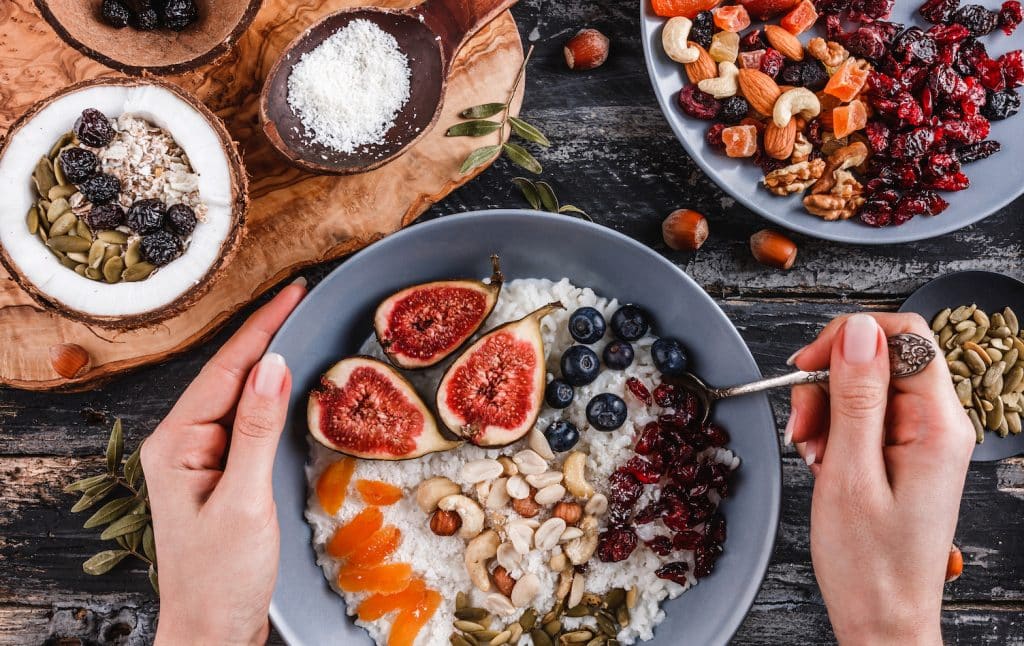
If you’re on social media, it’s highly likely you’ve heard of seed cycling. According to some naturopaths and wellness gurus, the holistic approach can help balance your hormones, reduce PMS or menopause symptoms, and increase fertility.
While there are plenty of TikToks around #seedcycling—and plenty of influencers claiming how well it works—we wanted to get an expert opinion on the matter. So we talked to registered dietitian and MyFitnessPal Scientific Advisor Maya Feller, RD, to find out if there’s any science behind the trend, and whether or not it’s effective at balancing hormones.
What is seed cycling?
Seed cycling is a method of adding different types of seeds into your diet during the two main phases of your menstrual cycle.
The schedule:
- Days 1 to 14 (follicular phase): 1 tablespoon of flaxseed and pumpkin seeds per day
- Days 15 to 30 (luteal phase): 1 tablespoon of sesame and sunflower seeds per day
Research has shown that both flaxseed and pumpkin seeds contain lignans that support healthy estrogen levels, which is important in your follicular. Pumpkin seeds are also high in zinc, which can boost progesterone leading into the second half of your cycle.
As for during your luteal phase, sunflower seeds are rich in vitamin E, which can stimulate progesterone production, while sesame seeds contain lignans that can help regulate estrogen.
Does seed cycling actually work?
As evidenced, there is science behind the effects of certain seeds on a woman’s menstrual cycle. But as for seed cycling in particular? Feller says there isn’t really any research proving its effectiveness—at least not yet.
“It all makes sense and there are researchers I know who are looking into it, but it’s not quite ready for us to say to the masses, ‘This is what you should do at the four phases,’” she explains.
Other ways to balance your hormones
So if seed cycling isn’t yet a proven method for balancing hormones, what is? We asked registered dietitian Steph Tarnacki, RD, for some of her tips for healthier hormones and how to minimize PMS symptoms throughout your cycle.
1. Increase your iron intake
If you experience heavy periods, Tarnacki recommends prioritizing iron-rich foods like red meat, lentils, and fortified cereals or taking a supplement. “Iron deficiency can lead to fatigue, a decreased ability to focus and potential anemia,” she explains. Bonus points if you pair it with a source of vitamin C (think: citrus fruits or bell peppers), which improves iron absorption.
2. Supplement with zinc and magnesium
Studies have also shown that women who experience bad PMS symptoms like mood swings, cramps, and headaches have low levels of zinc. Zinc-rich foods include shellfish, legumes, and seeds. But according to Tarnaki, “It would take a lot of effort and planning to get the daily requirement of zinc through food—and if you’re a vegan or vegetarian it would be VERY difficult, so, I’d recommend a supplement.”
Magnesium is an important mineral that can help maintain bone strength, reduce inflammation, and relieve muscle cramps. Because many people are deficient in magnesium, Tarnacki suggests taking a supplement or eating foods like nuts, seeds, and leafy greens. “Magnesium is easier to get through food”, she explains. “One serving of nuts or seeds can get you 1/3-1/2 way to the daily recommendation.”
3. Cut down on salt
“Decreasing salt intake can help to decrease bloating by minimizing the amount of water you retain,” Tarnacki explains. She recommends limiting highly processed and packaged foods to avoid excess salt. You can track your sodium intake—and your iron intake—in the MyFitnessPal app.

At the end of the day, remember that hormone balance comes down to the basics. This is what Feller calls the pillars of health. “Are you eating? Are you sleeping? Are you well-hydrated? If not, let’s talk about tweaking those,” she says.
Tarnacki agrees, noting that the key is a nourishing whole foods diet with lean protein, healthy fats, and plenty of fruits and veggies.






